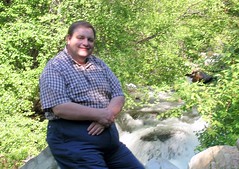Utah's Dixie
The Early Settlement of Southern Utah
At the October, 1853 conference in Salt Lake City, a group of fifty families and missionaries under the leadership of Rufus C. Allen (who had been trained in missionary work under Parley P. Pratt in South America) were "called" to strengthen the southern Utah Mission and labor among the Indians. The settlers left immediately but the missionaries delayed until the next spring.
In the meantime, the additional settlers had strengthened Harmony and an Indian school had been established. When the missionaries arrived, May 16, 1854, they found ten Indians in the school.35 Brigham Young visited Harmony on May 19 and while there inquired if a wagon road could be built to the Virgin River. He was given a discouraging reply.
A few days later, a number of the missionaries under Allen, pushed on to the south among the Virgin River Indians.36 On June 5, they descended Ash Creek and encountered a group of Indians near the present site of Toquerville. They made friends with the Indian Chief Toquer (meaning black, probably from the lava rocks) and bargained with him to send a runner to the neighboring Indians to arrange for a meeting with them. They moved on next day and met the other Indians at the present site of the old Washington Fields on the south side of the river.
These Indians were in a surly mood and had hidden their squaws and papooses; hence the Mormons were doubtful of their reception. However, one of them hunted up a hidden papoose and gave him a small pocket mirror which the child showed to the squaws. The trinket so pleased them that they all came out of hiding and quickly made friends with the whites.
The missionaries proceeded thence to the Santa Clara River by way of a trail north of the present site of St. George. Here they made friends with the Indians and laid the foundation for the establishment of a mission. The remainder returned to headquarters at Harmony, but Jacob Hamblin and William Henefer remained for some time on the Santa Clara working with the Indians and visiting others farther upstream. They did not reach Harmony until July.
[p.145] On June 21, 1854, a party of six under the leadership of David Lewis went west from Harmony to Mountain Meadows, down the Santa Clara and thence back over the mountains. On the trip, they preached to the Indians and baptized one hundred and nineteen into the Mormon Church, advising them thereafter not to steal or fight, but to learn Mormon ways of living. Two Indians were sent as messengers to the Muddy River Indians in Nevada, "To tell them we would come among them if they wanted us."37
The settlers at Harmony found a better location a few miles farther upstream on Ash Creek and during the summer of 1854 moved thither, calling it New Harmony. They built a fort there that fall. The missionaries in the Virgin and Santa Clara valleys found their remoteness inconvenient, accordingly a settlement was made on the Santa Clara where they could live among the Indians, and on December 1, Jacob Hamblin, Thales Haskell, Ira Hatch, Samuel Knight and A. P. Hardy established the nucleus of a permanent colony. Two weeks later Rufus Allen and Hyrum Burgess left Harmony for Tonaquint on the Santa Clara near its junction with the Virgin River where they built three log cabins. The missionaries helped the Indians construct substantial dams and ditches for diverting irrigation water. The first dam across the Santa Clara Creek, built in 1855, was a feat which aroused much enthusiasm among the Indians, five hundred of whom gathered to watch its completion. When the dam (100 feet long and 14 feet high) was finished and the water began to rise and run out, half on one side for the Indians and half on the other for the whites, a great shout of exultation went up from the dusky spectators.
The hard labor and poor nourishment which Jacob Hamblin had endured brought on a spell of sickness. To procure medicines and proper food for him, Gus Hardy went to Parowan. While there, Mrs. Nancy Anderson, a southerner, asked him about the mission of the Santa Clara and learned of the long, warm growing season. Believing that the climate might be suitable for cotton, she gave him a quart of cotton seed which she had brought with her from her old home. The missionaries planted the seed on the Santa Clara and raised a crop during the summer of 1855. This cotton was carded, spun, and woven into cloth by the women at the mission. Some of this cloth was sent to Salt Lake City and aroused no little interest there. Samples of the cloth even found their way into England and were said to compare favorably with cotton grown elsewhere. This was the beginning of cotton culture there, which finally led to the fuller settlement of the "Utah Dixie" along the Virgin River, [p.146] much as the iron industry had led to the development of Iron County, Moreover, like the iron industry, it answered a temporary need by supplying clothing when it was impracticable to import cotton.38


0 Comments:
Post a Comment
Subscribe to Post Comments [Atom]
<< Home